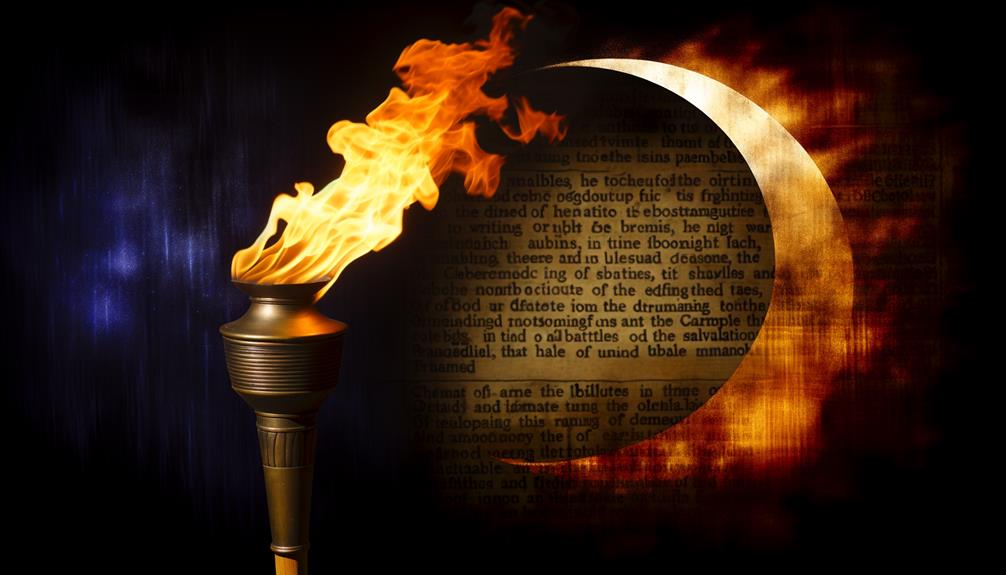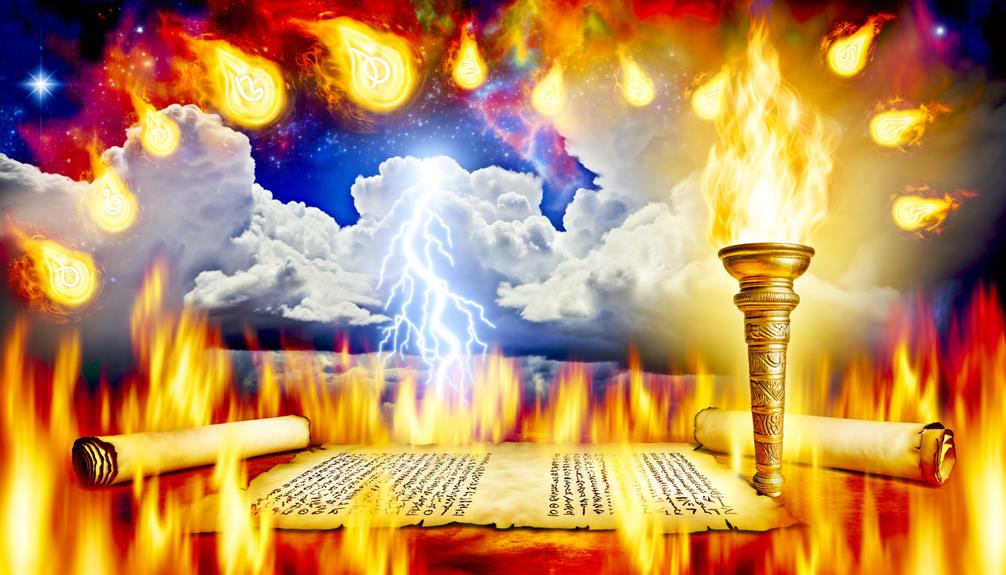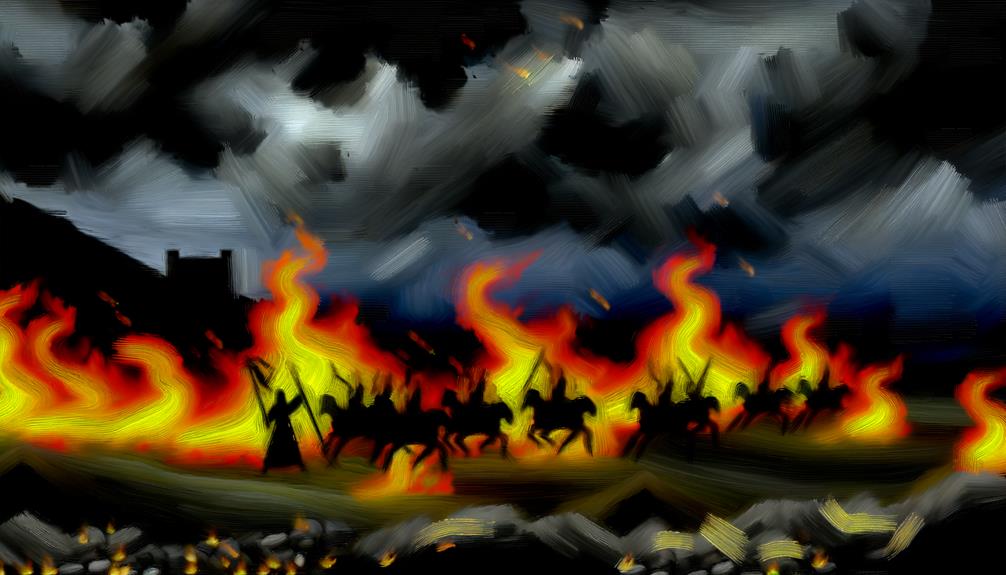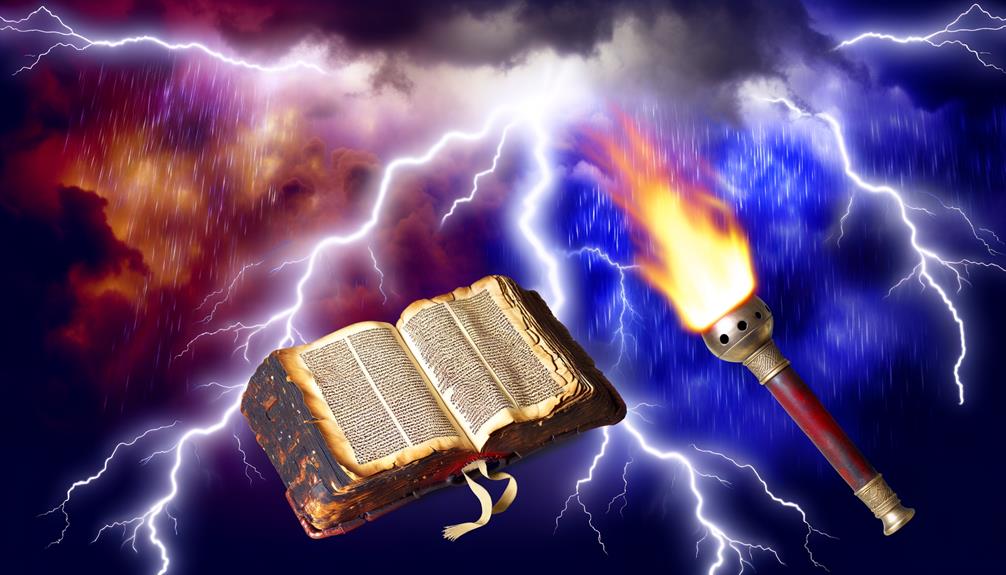Firebrand Meaning In The Bible: Zeal and Conflict
In biblical narratives, ‘firebrand’ symbolizes divine judgment and purification, accentuating God’s dual role as both righteous judge and merciful savior. The term appears in passages such as Isaiah 7:4, which describes adversaries as ‘smoldering stubs of firebrands,’ and Amos 4:11, where Israel is a ‘brand plucked from the burning,’ highlighting divine mercy.
This imagery underscores transformative trials and the dual themes of retribution and redemption within the historical and theological framework. These rich symbolic references illuminate the gravity of divine messages and are essential for deeper comprehension of the scripture’s profound layers.

Firebrand Meaning in the Bible: Symbol of Judgment, Zeal, and Influence
| Aspect | Biblical Insight |
|---|---|
| Definition | A burning piece of wood; symbol of destruction or a passionate person |
| Key Scripture | Zechariah 3:2 – Is not this a brand plucked out of the fire? |
| Symbolism | Judgment, rescue, zeal, or a person ignited with purpose |
| Spiritual Meaning | Represents someone saved from destruction and set apart for divine use |
| Historical Context | Used both literally (burning object) and metaphorically (influence or danger) |
| Application | A call to recognize divine rescue and live with bold, godly purpose |
Etymology and Definition

Frequently encountered in biblical texts, the term ‘firebrand‘ derives from the Old English word ‘fyrbrand,’ meaning a piece of wood that is burning or has been set on fire.
Theologically, it symbolizes both destruction and purification, reflecting divine judgment and cleansing.
Scripturally, ‘firebrand’ often conveys the idea of intense, purifying forces directed by God, aligning with the metaphorical use of fire in biblical literature.
Historically, the concept of a firebrand is embedded in ancient agrarian societies, where fire was a tool for both refinement and devastation.
Understanding the etymology and definition of ‘firebrand’ provides critical insight into its multifaceted role in scripture, enhancing the comprehension of its theological implications and the broader narrative it occupies within biblical contexts.
Old Testament References

In the Old Scriptures, the term ‘firebrand‘ appears in various contexts, often symbolizing God’s judgment and the purifying trials faced by His people.
For instance, in Isaiah 7:4, the prophet refers to the enemies of Judah as ‘two smoldering stubs of firebrands,’ indicating their imminent destruction and divine judgment.
Similarly, in Amos 4:11, Israel is described as a ‘brand plucked from the burning,’ illustrating God’s mercy in delivering them from deserved calamity.
Historically, such references highlight the dual nature of God’s interaction with humanity: both as a righteous judge and a merciful savior.
The imagery of a firebrand consequently serves to underscore themes of divine retribution, purification, and the potential for redemption amidst trials.
New Testament Insights

In the New Scripture, the term ‘firebrand‘ evokes rich symbolism and nuanced interpretation, often associated with fervor and transformative action.
Key scriptural references such as James 3:6 highlight the potent and potentially destructive power of the tongue, drawing a parallel to fire.
Symbolism and Interpretation
Within the New Covenant, the term ‘firebrand’ often serves as a potent symbol of divine judgment and purification, reflecting the transformative power of God’s intervention in human affairs.
In the New Agreement, references to fire frequently denote God’s purifying presence (1 Corinthians 3:13-15) and an agent of transformative judgment (Matthew 3:11-12). This symbolism aligns with the Jewish understanding of fire as both destructive and purifying, as seen in the Old Agreement (Zechariah 3:2).
The Apostle Paul’s teachings emphasize that believers, as firebrands, are refined through trials to reveal true faith (1 Peter 1:7).
Consequently, ‘firebrand’ encapsulates the dual aspects of divine correction and sanctification, underscoring the New Covenant’s emphasis on spiritual renewal and holiness.
Context in Scriptures
The New Scripture provides rich context for understanding the term ‘firebrand,’ particularly through its frequent allusions to fire as a symbol of divine presence and action. In the New Covenant, fire signifies not only purification but also judgment and the Holy Spirit’s empowering presence. For instance, in Matthew 3:11, John the Baptist speaks of Jesus baptizing with the Holy Spirit and fire.
| Scripture | Context | Symbolism |
|---|---|---|
| Matthew 3:11 | Baptism by Holy Spirit | Purification, empowerment |
| Acts 2:3 | Pentecost | Holy Spirit as tongues of fire |
| 2 Thess. 1:7-8 | Christ’s return | Judgment, retribution |
| Hebrews 12:29 | God’s nature | Consuming fire |
| Revelation 1:14 | Vision of Christ | Eyes like blazing fire |
These passages illuminate firebrand’s multifaceted roles in divine communication and action.
Symbolism in Prophecy

The imagery of firebrands in biblical prophecy often signifies fiery divine messengers (Isaiah 7:4), embodying both the transformative power of prophecy and the dual themes of judgment and redemption.
Through historical accounts and scriptural references, such as Zechariah 3:2, where a firebrand plucked from the burning represents Israel’s deliverance, we witness the multifaceted symbolism embedded in prophetic literature.
This rich symbolism underscores the profound theological implications of divine intervention and moral renewal.
Fiery Divine Messengers
Throughout biblical prophecy, fiery divine messengers often symbolize God’s powerful presence and impending judgment.
In Ezekiel 1:13-14, the living creatures appear as ‘burning coals of fire,’ emphasizing divine purity and authority. Similarly, in Isaiah 6:6-7, a seraphim touches Isaiah’s lips with a live coal, signifying purification.
Historically, fire represents both God’s holiness and His wrath, as seen when angels wield flaming swords in Genesis 3:24, barring Eden.
The prophetic imagery of fiery messengers underscores the urgency and gravity of God’s messages. Such symbolism, deeply rooted in ancient Near Eastern traditions, conveys an awe-inspiring reminder of divine intervention, echoing through the ages as a witness to the sacred and transformative nature of prophetic revelations.
Transformative Power of Prophecy
Prophecy in the Bible often wields a transformative power, employing profound symbolism to convey divine intentions and catalyze spiritual renewal. Scriptural narratives frequently utilize imagery to reveal God’s plans and prompt a deeper commitment to faith.
For instance, Ezekiel’s vision of the valley of dry bones (Ezekiel 37:1-14) symbolizes Israel’s restoration, illustrating God’s power to revive and renew His people. Similarly, the prophetic firebrand in Zechariah 3:2, representing Joshua the high priest, signifies divine selection and purification.
These symbols serve to awaken spiritual awareness, challenge complacency, and inspire repentance. By embedding profound allegories within prophecies, Biblical texts transform abstract divine messages into tangible, impactful experiences, thereby fostering a dynamic and evolving relationship between humanity and the divine.
Judgment and Redemption Symbolism
In Biblical prophecy, judgment and redemption are frequently symbolized through vivid imagery and narratives, reflecting God’s justice and mercy as seen in passages like Isaiah 1:18 and Malachi 3:2-3.
Isaiah 1:18 speaks to the transformative power of redemption, ‘though your sins are like scarlet, they shall be as white as snow,’ signifying purification.
Malachi 3:2-3 portrays God as a refiner’s fire, purging impurities to restore righteousness.
Historically, these symbols underscore the dual themes of divine retribution and grace.
Prophets utilized such potent imagery to communicate profound theological truths, illustrating the inevitable judgment for sin and the hopeful promise of redemption.
These symbols resonate deeply, offering a balanced understanding of God’s nature and His covenant relationship with humanity.
Firebrand as Divine Judgment

Used as a symbol of divine judgment, the term ‘firebrand’ in the Bible often signifies God’s wrath and impending punishment, as illustrated in passages like Isaiah 7:4 and Amos 4:11.
In Isaiah 7:4, the smoldering firebrands represent the impending doom awaiting the kingdoms of Syria and Israel due to their defiance against God’s will.
Amos 4:11 uses the imagery of a firebrand to depict Israel as a nation nearly consumed by divine judgment but momentarily spared, underscoring the severity of their sins.
Historically, firebrands connote destruction and purification, symbolizing how divine judgment eradicates iniquity and purifies the faithful.
This theological motif accentuates God’s justice and the urgency for repentance among His people.
Role of Prophets

The prophets, as God’s chosen messengers, played a pivotal role in conveying divine warnings and revelations to the people of Israel, urging them to repent and return to righteousness.
Figures such as Isaiah, Jeremiah, and Ezekiel communicated God’s will, often using metaphorical language, including the imagery of firebrands, to depict impending judgment (Isaiah 7:4, Amos 4:11).
Their messages were not merely predictive but were calls to ethical and spiritual renewal, grounded in covenantal theology.
Historically, prophets addressed societal injustices and idolatry, emphasizing adherence to the Mosaic Law.
Enemies as Firebrands

Often, biblical texts depict enemies as firebrands to symbolize their capacity for destruction and their role in divine judgment (Isaiah 7:4). This imagery is rooted in the ancient Near Eastern context, where firebrands, or burning sticks, were used as weapons of war and tools of devastation.
In Isaiah 7:4, the prophet refers to the kings of Aram and Israel as ‘smoldering stubs of firebrands,’ indicating their impending downfall and the temporary nature of their threat. The use of firebrand imagery underscores the transient yet intense danger posed by such adversaries.
Scripturally, this metaphor aligns with the broader biblical narrative, where enemies often serve as instruments through which divine justice and judgment are executed, ultimately reaffirming God’s sovereignty.
Firebrand and Social Upheaval

Throughout biblical literature, firebrand imagery frequently symbolizes the catalysts of social upheaval, reflecting both the immediate impact and the far-reaching consequences of societal disruptions (Judges 15:4-5).
The acts of Samson, who ignited the Philistine fields by releasing foxes with firebrands tied to their tails, exemplify the sudden and destructive nature of such forces.
This symbolic use of firebrands highlights the disruptive agents within a community or nation, often leading to significant transformation or judgment.
Historical context underscores that these acts were not merely personal vendettas but divine instruments of change, provoking reflection on divine justice and societal reformation.
Consequently, firebrand imagery serves to reveal the dynamic interplay between human actions and divine intervention within biblical narratives.
Lessons for Believers

In reflecting on the symbolic use of firebrands in biblical narratives, believers are called to understand the profound lessons regarding divine justice and the transformative power of righteous action within their own lives.
The prophet Amos, for instance, speaks of Israel as a firebrand plucked from the burning (Amos 4:11), illustrating God’s mercy amidst judgment.
Similarly, Isaiah 7:4 warns King Ahaz against fearing two smoldering firebrands, symbolizing transient threats.
These instances urge believers to trust in God’s sovereignty and respond to divine calls for justice and repentance.
Historically, firebrands denote both destructive and purifying forces, compelling believers to be instruments of righteous change, embodying the fervent and purifying zeal exemplified in scripture.
Modern Interpretations

Modern interpretations of the term ‘firebrand‘ often draw upon its rich scriptural heritage to address contemporary issues of passion and conflict.
In today’s cultural landscape, the metaphor has expanded to symbolize fervent activism and radical change, reflecting the intensity and disruptive potential originally depicted in biblical texts such as Amos 4:11.
This evolving significance underscores the enduring relevance of biblical imagery in framing and understanding current societal dynamics.
Contemporary Symbolism
Contemporary interpretations of the term ‘firebrand‘ in biblical texts often draw on its rich historical and theological connotations to address modern spiritual and social issues.
Traditionally, a ‘firebrand’ refers to a piece of burning wood, symbolizing someone who incites action or change. In Isaiah 7:4, it depicts enemies as ‘smoldering firebrands,’ indicating imminent danger and unrest.
Today, this term is applied to passionate leaders or activists who inspire transformation within communities. By invoking the fervor and urgency inherent in the biblical ‘firebrand,’ modern interpretations emphasize the necessity of zeal and moral conviction in confronting contemporary challenges.
This metaphorical use bridges ancient scriptural wisdom with the dynamic landscape of current societal movements.
Cultural Relevance Today
Building on the historical and theological insights, the term ‘firebrand‘ continues to resonate profoundly within today’s cultural and spiritual landscape.
In modern contexts, a ‘firebrand’ often symbolizes a fervent advocate or a passionate reformer, akin to the biblical prophets who fervently called for societal and spiritual renewal (Jeremiah 20:9).
This term captures the essence of individuals who challenge the status quo, much like John the Baptist (Matthew 3:1-12).
Historically, firebrands have incited transformative movements, embodying the spirit of divine zeal and justice demonstrated in scriptures.
This enduring imagery underscores a timeless call to prophetic action, inspiring contemporary believers to embody the fervor and commitment reminiscent of biblical exemplars in their pursuit of righteousness and reform.
Conclusion
The term ‘firebrand‘ in biblical texts encompasses a rich tapestry of meanings, from divine judgment to social upheaval.
As a metaphor, consider the story of Gideon in Judges 7:16-22, where torches hidden in clay jars become instruments of deliverance, reflecting how God can use even the most unassuming elements to ignite profound change.
This underscores the significance of ‘firebrand’ as a symbol of God’s transformative power, offering valuable lessons for contemporary believers traversing a complex world.






